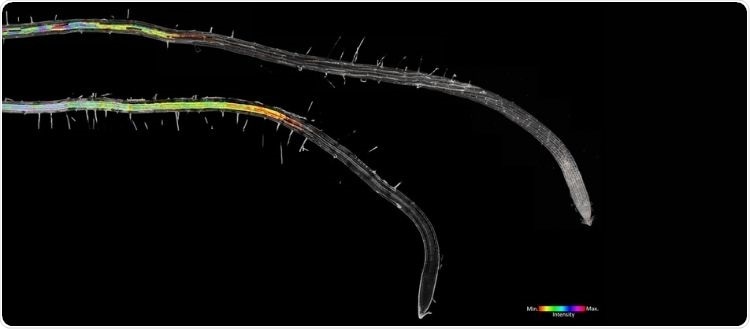Plants modify the permeability of their roots to adapt to their nutritional needs. This takes place through the degradation or production of a cork-like layer named suberin.

Visualization of suberin (induced toward the root tip on the left) in Arabidopsis thaliana, with an intensity-stained gradient. Image Credit: © University of Geneva.
By analyzing the regulation of this protective layer in Arabidopsis thaliana, an international group, headed by researchers from the University of Geneva (UNIGE), Switzerland, identified four molecular factors accountable for the genetic activation of suberin.
The identification of these factors enabled the production of plants with roots that are continuously covered—or, conversely, fully lacking—of suberin. For the selection of plants more resistant to environmental stresses, these factors are of significant interest. The study was published in the Proceedings of the National Academy of Sciences (PNAS) journal.
The uptake of water and nutrients by root from the soil should be selective, particularly when the environment is toxic to the plant. Suberin, found in plant roots, is a substance made of lipids that work as a protective barrier against numerous environmental stresses.
Earlier research carried out by Marie Barberon, professor at the Department of Botany and Plant Biology at the Faculty of Science of the UNIGE, has revealed that suberin—the major component of cork—can shield the cell walls, or contrarily be degraded to alter the permeability of the roots to nutrients found in the environment.
Thus, the suberin layer safeguards the plant from water loss and toxic elements like cadmium or salt; however, it can also optimize the possession of necessary nutrients for growth.
Four key factors in the model plant Arabidopsis
To comprehend the regulation of suberin’s presence, an international group, headed by Marie Barberon, was interested in specific regulators found in the endodermis—the cell layer around the vessels carrying the sap that forms suberin. The research was performed in Arabidopsis thaliana—the commonly used model organism in plant biology.
We were able to use one of the characteristics of this plant, namely the transparency of its roots, to observe directly in microscopy the presence or absence of suberin after staining and could identify the factors essential for its production. We thus obtained plants whose roots are always covered with suberin. Using the CRISPR/Cas9 technique, we also generated a quadruple mutant for these proteins that are impaired in suberin production.”
Vinay Shukla, Study First Author and Researcher, Department of Botany and Plant Biology, University of Geneva
This permitted the biologists to pinpoint the four major proteins responsible for the formation of suberin in the endodermis.
Towards super-resistant plants
The modified Arabidopsis plants were later grown in environments with various levels of sodium—a nutrient present in salt and vital for plant growth. However, sodium can be toxic if found in high concentrations in the soil.
We observed that plants whose roots are continuously covered with suberin absorb less sodium than those without. On the other hand, the latter are less resistant to toxic concentrations.”
Marie Barberon, Department of Botany and Plant Biology, University of Geneva
This identification of the major factors regulating suberin formation in roots offers useful genetic tools to analyze more accurately its role in retaining the nutrient balance in plants, along with resistance to salt stress, flooding, or drought. The observations can also probably have a significant agronomical impact, by employing the factors discovered from the research as root traits to choose plants highly resistant to adverse environmental conditions.
Source:
Journal reference:
Shukla, V., et al. (2021) Suberin plasticity to developmental and exogenous cues is regulated by a set of MYB transcription factors. Proceedings of the National Academy of Sciences. doi.org/10.1073/pnas.2101730118.